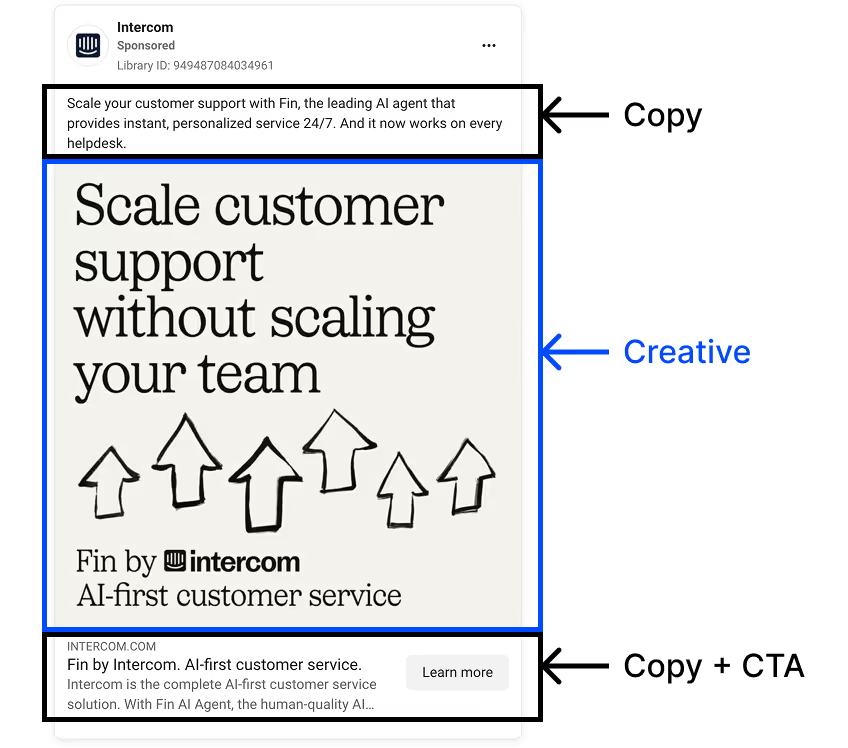Introduction: Ad Creatives
The era of the data-driven marketer is over.
Ad platforms are so sophisticated now that you can just throw some creatives in an Advantage+ campaign and get solid conversions—without meticulously tweaking audience targeting, bid strategies, or manual optimizations like before.
In fact, getting too fancy with manual targeting can actually hurt your performance.
The algorithm does all the heavy lifting for you.
So, what moves the needle now?
Ad creative.
Creatives are:
- The new targeting.
- The new competitive advantage.
- The difference between a profitable campaign and a flop isn’t how well you analyze your metrics
It’s all about how scroll-stopping, engaging, and persuasive your creative is.
And the best part? Anyone can make great creatives with the principles and tools we’re about to share. You don’t have to be a designer or expert copywriter to make some solid ad creatives that convert.
But first, to clarify one thing…
What is an ad creative?
Ad creatives are the visuals in your ads—images, videos, carousels, or UGC (user-generated content). They grab attention, stop the scroll, and ultimately dictate whether someone clicks or not.

If your ads aren’t converting?
It’s likely not your targeting—it’s your creative.
Our ad creative philosophy
The key to ad creatives is to:
- Don't make people think. It should be immediately obvious to them at a glance.
- Don't be fancy. Simple, clean, and straightforward is almost always best.
- Try not to be a “creative copywriter.” You're not trying to win an award, you're trying to sell a product.
Let’s face it: your “creative ad” will only work if you’re a big brand like McDonalds.
Not if you’re a startup no one knows yet. When you’re unknown, your creatives need to be direct and to the point. You can’t make people think.
Even those creative ads that win awards mostly just get praise from other advertisers, and don't necessarily do what matters: drive sales.
The more "intellectually interesting" or out-of-the-box creative the ad is, often the less likely it will be to convert.
And don't bury the lede with your ad.
You have milliseconds to intrigue someone.
Don't have something confusing and obscure in the headline only to show the real value in the subheader.
People don't read the subheader if the header is confusing.
Example of a recruiting ad that still makes people think: "Hire in 48 hours"
- hire who?
- does it cost money?
Get in the mindset of the audience
You can't produce ad creatives that resonate with people if you don't deeply understand:
- Who they are
- What problems they're struggling with
- What they're worried about
- What their selfish desires are
- What they care about
Don't just think about their age, gender, location, or job. Think about the context they're in. Think about their culture. Think about
If they see an ad on instagram, where are they at that moment? Probably chilling on the couch, tv on, scrolling on their phone, their wife is nagging them, the cat just pushed something off the table. A lot of stimulus going on.
They're not going to sit down and read your ad unless you give them a really good reason to.
Don't talk about you, talk about them
Don't say "we're the best company to do X in the world"
Say "We'll solve X problem for you better than anyone in the world"
We're all selfish creatures. We care first and foremost about how others will solve our problems and make our lives better. Not what makes THEM great.
Kill your darlings
Ruthlessly cut meaningless words or elements that don't add to the value of what you're saying.
"Get growth hires for free in your inbox"
- What does "in your inbox" have to do with anything? Does that mean anything? You can cut this to say, “Get growth hires for free.”
Key components of performant ads
Consumer neuroscience research has found that highly successful ads score well on three key dimensions:
- Attention (ex: familiarity + peculiarity),
- Conversion to long-term memory (ex: peculiarity + humor),
- Emotional engagement (ex: humor)
You want to create ads that check those boxes.


